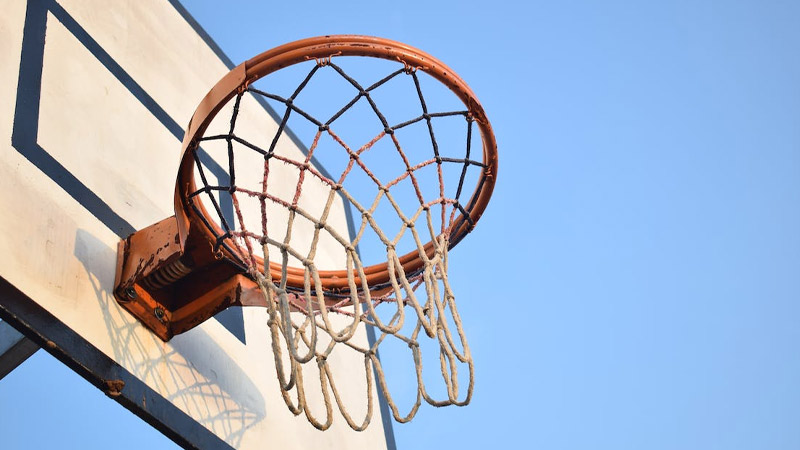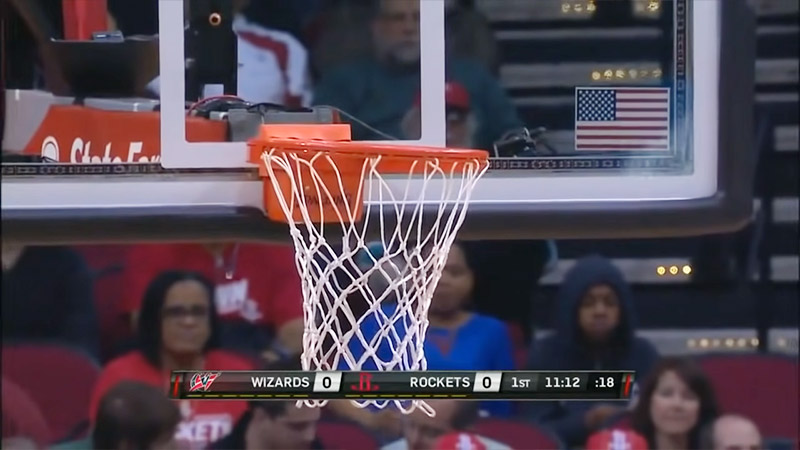Basketball is a sport known for its fast-paced action, skillful plays, and nail-biting moments that keep fans on the edge of their seats. Among the many captivating scenarios that unfold on the court, few are as suspenseful and intriguing as the phenomenon of “rim rest.”
In this blog post, we delve into the world of basketball’s rim rest, unraveling the mechanics behind this heart-stopping occurrence.
From understanding how it happens to its impact on the game, we’ll uncover the secrets of rim rest and why it’s a favorite among players and fans alike.
What Is the Rim Definition in Basketball?
In basketball, the term “rim” refers to the metal hoop that is suspended horizontally at a height of 10 feet (3.05 meters) above the floor. The rim is an essential component of the basketball hoop, and players aim to score points by shooting the basketball through the rim.
The rim is circular and has an inner diameter of 18 inches (45.7 centimeters). It is connected to the backboard, which is typically made of transparent glass or acrylic material.
When a player successfully shoots the ball through the rim from above and it passes through the net, they score points for their team.
The number of points awarded varies based on the location from which the shot was taken, such as two points for a regular field goal and three points for a shot made from beyond the three-point line.
What Is Rim Rest Basketball?
“Rim rest” or “ball sitting on the rim” in basketball refers to a situation where the basketball comes into contact with the rim but doesn’t immediately fall through the hoop or bounce away.
Instead, the ball may come to a brief pause, often balancing on the rim itself, before either dropping through the hoop or falling off the rim and back into play. When a ball sits on the rim and stops spinning or rotating, it can create moments of suspense during a game.
Players and spectators eagerly watch to see if the ball will eventually drop through the hoop for a successful shot or if it will bounce off the rim, potentially allowing for another player to grab the rebound and continue the play.
If the ball remains on the rim for an extended period of time without falling, players might attempt to tip it in or tap it out, depending on their team’s strategy and the positioning of players on the court.
Rim rests can lead to exciting and memorable moments in basketball games, as they introduce an element of uncertainty and drama to the game’s flow.
How Does Rim Rest Happen in Basketball?

“Rim rest” situations in basketball occur due to the interaction between the basketball, the rim, and the backboard. Here’s how it typically happens:
Shot Angle and Velocity
When a player takes a shot, the angle at which the ball approaches the rim and the velocity at which it travels play a significant role. If the ball has enough arc and velocity, it can hit the rim and bounce off in a normal trajectory.
However, if the ball’s angle and velocity are just right, it can hit the rim in a way that causes it to slow down and possibly come to rest on top of the rim.
Backspin and Rotation
The rotation and backspin on the basketball can also influence how it interacts with the rim. If the ball has a certain amount of backspin, it might create a “soft” bounce off the rim, reducing the ball’s kinetic energy upon impact.
This can increase the chances of the ball settling on the rim rather than bouncing away.
Rim Contact
When the ball makes contact with the rim, the shape of the rim and the force of the impact play a role. The rim is not a completely flat surface; it has a curved profile.
Depending on where the ball hits the rim and the angle of impact, it can create a scenario where the ball temporarily balances on the rim’s edge.
Friction and Surface Interaction
Friction between the ball and the rim/backboard also affects how the ball behaves upon impact. If the friction is high and the ball’s movement is slowed down upon hitting the rim, it’s more likely to stay in proximity to the rim instead of bouncing away immediately.
Gravity and Rebound
The combination of gravitational force and the ball’s rebound properties determines whether the ball eventually falls through the hoop or bounces off the rim.
If the ball’s balance on the NBA rim is stable enough, it might stay in that position for a brief moment. However, gravity will eventually cause the ball to shift, leading it to either fall through the hoop or drop off the rim and back into play.
It’s important to note that rim rests are relatively rare occurrences and often create moments of excitement and tension during basketball games.
Players and fans alike eagerly watch to see whether the ball will drop in for a score or if it will require another action, such as a rebound attempt or a gentle tap from another player, to decide the outcome.
Impact of Rim Rest
The occurrence of a “rim rest” situation in basketball can have several impacts on the game, the players, and the overall atmosphere of the match. Here are some ways in which rim rests can influence the game:
Suspense and Excitement
Rim rests create moments of intense suspense and excitement. Players, coaches, and fans alike hold their breath as they watch to see if the ball will eventually drop through the hoop or bounce away. The uncertainty of the outcome adds a thrilling element to the game.
Dramatic Moments
Rim rests often lead to dramatic moments that are remembered long after the game has ended. Whether the ball eventually falls through the hoop or not, these moments become part of the game’s highlights and discussions.
Strategy and Rebounding
When a ball is in a rim rest situation, players need to quickly assess the situation and react. If the ball falls through, points are scored, but if it stays on the rim, players might need to position themselves strategically to either tip the ball in or secure the rebound for their team.
Turnarounds and Momentum Swings
The outcome of a rim rest scenario can influence the momentum of the game. If the ball eventually falls through for a score, it can provide a psychological boost to the scoring team and potentially shift the momentum in their favor.
On the other hand, if the ball bounces off the rim, the defensive team gains an opportunity to regain possession and potentially counterattack.
Fan Engagement
Rim rest situations engage fans in a unique way. The collective anticipation and reaction of the crowd during these moments create a shared experience that brings fans closer to the action on the court.
Highlight Reels and Memorable Moments
Successful rim rest shots, where the ball drops through the hoop after a suspenseful pause, often become part of highlight reels and memorable moments in basketball history.
These moments are celebrated by fans and can even become iconic representations of a player’s skill and composure.
Rule Clarification
Sometimes, rim rest situations might lead to discussions or clarifications regarding the rules of the game. Officials and referees might need to determine whether the ball is still considered “live” when it’s sitting on the rim or if any specific rules apply in such situations.
NBA Rim rest situations add an extra layer of drama and unpredictability to basketball games, contributing to the unique appeal and excitement of the sport.
FAQs
How high is the NBA rim?
The NBA rim is set at a height of 10 feet (3.05 meters) above the floor. This standard rim height is consistent across professional basketball leagues, including the National Basketball Association (NBA).
The height of the rim plays a crucial role in the game, as players must shoot the basketball into the hoop from various distances and angles to score points for their teams.
How big are NBA rims?
NBA rims have a standard size with an inner diameter of 18 inches (45.7 centimeters). This diameter refers to the circular opening through which the basketball must pass in order to score points.
The rims are made of metal and are attached to the backboard, which is typically made of transparent glass or acrylic material.
The size of the rim remains consistent across professional basketball leagues like the National Basketball Association (NBA) to ensure uniformity and fairness in the game.
What impact does rim rest have on the game?
The impact of rim rest is multi-faceted. It injects intense suspense and excitement into the game, creating dramatic moments that fans remember.
The outcome can influence momentum, strategic decisions, and even fan engagement. Successful rim rest shots often become iconic moments, while the scenario itself requires quick thinking and reactions from players.
Can players influence the outcome of rim rest situations?
Absolutely. Players can attempt to tip the ball in gently if it’s perched on the rim or position themselves strategically to secure the rebound if the ball eventually bounces off. These decisions can impact scoring opportunities and possession changes.
Are there any specific rules regarding rim rest?
While the rules of basketball govern most aspects of play, rim rest situations don’t have their own unique set of rules. However, officials must determine if the ball is still considered “live” while on the rim and apply standard rules accordingly.
Wrapping Up
Rim rest in basketball is more than just a suspenseful moment—it’s a testament to the intricate dynamics of the game. From the physics behind its occurrence to the emotional rollercoaster it provides, rim rest adds an extra layer of thrill to an already captivating sport.
Whether it leads to a thrilling score or sets the stage for a crucial rebound, rim rest remains one of basketball’s most cherished and talked-about phenomena.
As players continue to showcase their skill and composure in the face of this unique challenge, fans can eagerly anticipate the next heart-stopping rim rest moment that will etch itself into basketball history.







